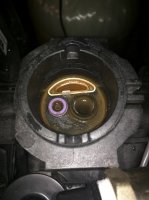Terry Richards
New Member
Greetings,
Many thanks to all the contributors on this forum for creating an amazing archive of all things plumbing.
Background: Well water (10 GPM tested), south suburbs of Chicago. Hardness 30 gpg, TDS 450 ppm, Iron 7 ppm. 20 year old 1.5 cu/ft softener was not keeping up with iron, creating whole house issues with toilet/laundry staining and clear evidence of IRB’s. IRB inferred by dark slimy tank and sulfur smell in hot water, always solved temporarily by introducing peroxide into the water heater.
After research on this forum (thanks again!), decided on the following solution:
When the iron filter was first brought online, it was water nirvana. I observed the TDS drop from 450 → 300 ppm (unsure if this is related in any way to iron reduction) and I could not detect the slightest taste of iron or smell of sulphur. I honestly wondered if the 2.5 cu/ft softener was even warranted!
Fast forward 3 weeks: softener is working like a champ, regenerating every 10 days with completely soft water through the entire duration (as tested with Hach 5b). The iron filter however, appears to have stopped working as TDS is back up to 450 exiting the filter and there is a distinct iron taste though no apparent sulfur. The water quality is nearly indistinguishable from the raw well. This implies the water softener is doing the job for both currently, removing up to 7 ppm of iron.
What I have checked:
None of these steps appear to have worked and I can detect iron from the output right after regeneration. I did note the valve in question received “rough shipment”, though it appears completely fine, has never thrown an error code, and cycles without issue.
Any suggestions on how to definitely diagnose the distributor would be very helpful. This would allow me to concentrate on whether this may be PH or IRB related.
Regards and a Happy New Year,
Terry Richards
Many thanks to all the contributors on this forum for creating an amazing archive of all things plumbing.
Background: Well water (10 GPM tested), south suburbs of Chicago. Hardness 30 gpg, TDS 450 ppm, Iron 7 ppm. 20 year old 1.5 cu/ft softener was not keeping up with iron, creating whole house issues with toilet/laundry staining and clear evidence of IRB’s. IRB inferred by dark slimy tank and sulfur smell in hot water, always solved temporarily by introducing peroxide into the water heater.
After research on this forum (thanks again!), decided on the following solution:
- Repipe copper from ¾” → 1” from pressure tank to filter complex
- Repurpose existing 10x54 tank with gravel and 1.5 cu/ft Katalox Light
- Iron filter uses new Fleck 7000 softener valve, pot-perm tank and dilute bleach solution for regeneration every 2 days
- Valve DLFC was changed out for 7 GPM button
- New 13x54 tank, gravel, 2.5 cu/ft 8% cation
- Softener uses new Fleck 7000 softener valve. original salt tank
When the iron filter was first brought online, it was water nirvana. I observed the TDS drop from 450 → 300 ppm (unsure if this is related in any way to iron reduction) and I could not detect the slightest taste of iron or smell of sulphur. I honestly wondered if the 2.5 cu/ft softener was even warranted!
Fast forward 3 weeks: softener is working like a champ, regenerating every 10 days with completely soft water through the entire duration (as tested with Hach 5b). The iron filter however, appears to have stopped working as TDS is back up to 450 exiting the filter and there is a distinct iron taste though no apparent sulfur. The water quality is nearly indistinguishable from the raw well. This implies the water softener is doing the job for both currently, removing up to 7 ppm of iron.
What I have checked:
- inspected injector and screen, both nominal
- Performed drain line smell test. There is no immediate smell of bleach, but is evident after only 3 minutes
- Removed valve and thoroughly inspected distributor and distributor interface. Note this is a 1.05” size with the 61419 adapter installed and the original o-ring and snap-ring removed. I cannot remove the adapter and while it did not “snap” in place, it appears installed correctly
- Stepped up regeneration from 3 → 2 days. B1: 7, BD: 60, B2: 3, RR: 6, BF: 16
None of these steps appear to have worked and I can detect iron from the output right after regeneration. I did note the valve in question received “rough shipment”, though it appears completely fine, has never thrown an error code, and cycles without issue.
Any suggestions on how to definitely diagnose the distributor would be very helpful. This would allow me to concentrate on whether this may be PH or IRB related.
Regards and a Happy New Year,
Terry Richards

